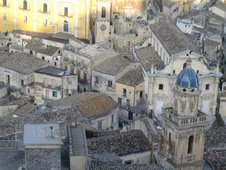
1- Try to rent a car and invest in a good map, more often than not places are not clearly indicated. Fortunately people are usually pretty patient, and will try to help you find your way.
2- Visit the amazing Agrigento’s Valley of the Temples (Valle dei Tempi) with an impressive array of well preserved Greek temples dating from 400-500 BC. I strongly recommend that you avoid this visit in august. If you have no choice, you can take a few precautions: apply sunscreen, wear a hat and carry a bottle of water, you’ll be walking under the sun for a long time and the temperature can easily reach the 100º Fahrenheit. I recommend that you go on the first two weeks of February if possible, during the almond tree festival that celebrates Agrigento’s early blossom of the almond trees.
3- Have a "Granita" with "Brioche"... granita is a sort of sherbet made of a frozen mix of water, sugar and flavoring. Usually you’ll find such flavors as coffee, chocolate, pistachio, almond, lemon, strawberry and other fruits. The brioche is a sort of semi-circular muffin, that you can dip in your granita... If you plan to go to the city of Noto, don’t miss the best granita ever! Mandolfiore - Via Ducezio 2, Noto, Siracusa - Tel: 0931-836-615.
4- Visit the Villa at Casale, a Roman Villa dating from the 4th century located in Piazza Armerina. This villa represents an extraordinary testimony to the life in the roman era thanks to the lively scenes represented in the mosaic covered floors. These superb mosaics are really well preserved. Tel: +39 0935-680036

5- Some great cities include Palermo, Taormina with it’s impressive greek theater and dramatic sea view, Catania under the Etna volcano, and the cities of the Noto Valley (Noto, Siracusa, Modica and Ragusa) with some of the finest examples of late baroque architecture. While in Siracusa, make sure you visit the island of Ortygia, and while in Ragusa, the picturesque Ibla.
6- Let’s talk about food… it’s really hard to have a bad meal in Sicily. But each region has it’s specialties, so I recommend you ask in the restaurant about the typical food of that particular place and try it. Some examples include pane and panelle in Palermo (at the famous Antica focacceria San Francesco) Palermo, Via A. Paternostro, 58 - Tel. 091320264 - Closed on Tuesdays.
In the Ragusa area, I recommend you try the Ragusano DOP cheese with honey, and anything with the extra virgin olive oil from Giarratana. In Noto, the granita, (see number 3). In Catania, go to the kiosk in the main square and ask for "sgricchio" (SGREECHEEO) a sort of refreshing soda with different flavours, I like mandarina (tangerine). In Modica you should try the chocolate, any of their typical pastries and my favourite, the chocolate-chili liquor. In Bronte, the pistachio… and I coud go on and on for days since every place preserves it’s own traditions and flavours.
7- For a full meal, I would start with an antipasto (starter) of anything with eggplant (melanzana) or seafood. A first course will have to include at least a pasta dish, like pasta alla norma (again pasta with eggplant and ricotta, two of the icons of Sicilian cooking). The second or main course often includes fish or meat. I found the red meat for the most part disappointing, they also eat horse meat (it has a sweeter taste but can be quite though). If you are a carnivore, I believe the pork is a much better choice. If you can live without meat, have any of the excellent fish and seafood, often cooked with mastery.
8- If you want to stay in a more “authentic” way, there are Bed & Breakfasts everywhere, sometimes built in old houses that can let you experience the construction, furniture and decoration to have a closer look of local culture. If you are on a budget and you travel with a group of 3 to 4 people or more, you could try a vacation house, usually available on weekly basis. This is always a cheaper and less commercial way to stay. Another alternative can be an Agriturismo, italian farmhouses in or around a rural area, that produce their own food and sometimes offer accomodation so you can live the whole farm experience. The room type can vary a lot depending on the facility (private or shared bathrooms, etc). It is always wise to ask first... Some interesting websites: http://www.insidesicily.it, or http://www.agriturismo-sicilia.it/
9- As for the climate, I guess I've all been spoiled by L.A's perfect weather. Ragusa has a not-so-great climate, here winter is cold and (very) humid, specially by the sea, and summer is warm and sunny, but can get REALLY hot... luckily you can forget all that by consuming large amounts of creamy gelato. Anyway, I think good food, great beaches and a calendar full of holidays make up for the weather, which is probably still better than in many northern European countries. As for the rest of Sicily, it has reportedly better weather than Ragusa. So don’t worry too much… just remember to pack your sunscreen... or an extra pair of gloves!
10- Sicily offers, countless historical monuments, many natural wonders from sandy beaches with warm water to natural parks like the “
Reserva dello Zingaro,” the "
Gole del Alcantara" or the
Etna park. You also have any of the smaller islands like the Aeolian islands on the north east or the islands of Ustica (great for snorkeling) and Pantelleria (with clear influence of arab culture). Sicily is a place where the landscape, the tradition and the people show a different sensibility than the rest of Italy. A place whith it’s own personality and many options for tourism (beaches, landscapes, art, architecture, food and history).













